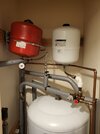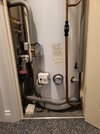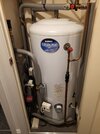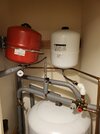Hi All,
I appreciate there are numerous similar posts but I'm look for clarification to judge whether I should try to replace radiator or have a plumber come out.
I have an Ideal Logic Heat 12 boiler and Tribune HE cylinder, circuit for hot water and 2 circuits for heating as I understand it. I've been trying to get my head around it a bit more but there's so much differing info out there. I'll attached some pics.
I am looking to install a new towel rail radiator in our bathroom. So far I have taken the old one off, closed the TRV and lockshield to do so and have left them be. Needed to get that off to do some prep on the wall.
I've read I could open up either side of the pipework one side at time? I'd need to do some re-working of the pipes to feed the new style radiator neatly. If that is possible and I managed to re-work and put new valves on, get the new radiator up - what then? How would I fill it and maintain system pressure*
Many thanks in hope of some help
* On a related note, while trying to figure this out I was tempted to follow some guidance somewhere about topping up pressure and opened the black handled valve on the flex attached to the pressure gauge. This did cause an increase in the reading (was sitting at 0.5, just let it go slightly to see it work) but the valve then started dripping steadily. Is that just normal for a rarely used valve? I did get it to stop by putting it just a smidge from hard off.
I appreciate there are numerous similar posts but I'm look for clarification to judge whether I should try to replace radiator or have a plumber come out.
I have an Ideal Logic Heat 12 boiler and Tribune HE cylinder, circuit for hot water and 2 circuits for heating as I understand it. I've been trying to get my head around it a bit more but there's so much differing info out there. I'll attached some pics.
I am looking to install a new towel rail radiator in our bathroom. So far I have taken the old one off, closed the TRV and lockshield to do so and have left them be. Needed to get that off to do some prep on the wall.
I've read I could open up either side of the pipework one side at time? I'd need to do some re-working of the pipes to feed the new style radiator neatly. If that is possible and I managed to re-work and put new valves on, get the new radiator up - what then? How would I fill it and maintain system pressure*
Many thanks in hope of some help
* On a related note, while trying to figure this out I was tempted to follow some guidance somewhere about topping up pressure and opened the black handled valve on the flex attached to the pressure gauge. This did cause an increase in the reading (was sitting at 0.5, just let it go slightly to see it work) but the valve then started dripping steadily. Is that just normal for a rarely used valve? I did get it to stop by putting it just a smidge from hard off.






